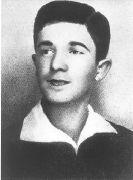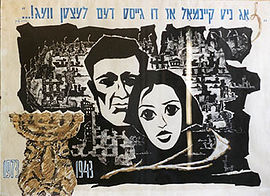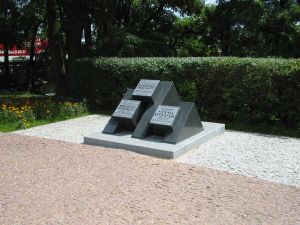Mordechai Anielewicz
Mordechai Anielewicz (1919 – May 8, 1943) was the commander of the Żydowska Organizacja Bojowa (English: Jewish Fighting Organization), also known as ŻOB, during the Warsaw Ghetto Uprising.
Born to a poor family in Wyszków near Warsaw, he joined and became a leader of the Zionist-socialist youth movement "Hashomer Hatzair" after he completed his high school studies. On September 7, 1939, a week after the German invasion of Poland, Anielewicz escaped with his members of the group from Warsaw to the eastern regions in the hopes that the Polish would slow down the German advance. When the Red Army finally occupied Eastern Poland, Anielewicz attempted to cross the Romanian border in order to open a route for young Jews to get to Mandatory Palestine; however, he was caught and thrown into a Soviet jail. He was released a short time later, and returned to the Warsaw Ghetto.
When he heard that Jewish refugees, other youth movement members and political groups flocked to Vilna, Lithuania, which was then under Soviet control, he went there too and convinced his colleagues to send people back to Poland to continue the fight against the Germans. He returned to Warsaw in January, 1940 with his girlfriend, Mira Fuchrer, where he organized cells and youngsters groups, instructed, participated in underground publications, organized meetings and seminars and visited other groups in different cities.
In the summer of 1942, Anielewicz was visiting the southwest region of Poland – annexed to Germany – attempting to organize armed resistance. Upon his return to Warsaw, he found that a major deportation to the Treblinka extermination camp had been carried out and only 60,000 of the ghetto's 350,000 Jews remained. He joined the ŻOB, and in November he was appointed as chief commander. In early 1943, a connection with the Polish government in exile in London was made and the group received weapons from the Polish underground on the "Aryan" side of the city.
In January 18, 1943, he was instrumental in the first Warsaw ghetto uprising, preventing the majority of a second wave of Jews from being deported to extermination camps. This initial incident of armed resistance was a prelude to the Warsaw ghetto uprising that commenced on April 19 and fought the German troops until its suppression on May 16, 1943. Anielewicz committed suicide, along with his girlfriend and many of his staff, in the ŻOB bunker at 18 Miła Street[1] on May 8, once their capture by the Germans was inevitable. His body was never found, and it's generally believed that his body was carried off to nearby crematoriums along with all the other Jewish dead. In early 1944 he had been posthumously awarded the Virtuti Militari, the Polish military cross, by the Polish government in exile.
Kibbutz Yad Mordechai in Israel is named for him, and a monument was erected in his memory.
Cultural references
- Anielewicz is a key figure in Harry Turtledove's alternate history series Worldwar.
- Hank Azaria plays the role of Anielewicz in the 2001 TV Movie Uprising.
Further reading
Yitzhak ("Antek") Zuckerman, A Surplus of Memory : Chronicle of the Warsaw Ghetto Uprising (A Centennial Book), ISBN 0-520-07841-1.
External links
- Mordecai Anielewicz article from the Jewish Virtual Library.
- Mordecai Anielewicz article from the Grange Museum Warsaw Ghetto Website.
Credits
New World Encyclopedia writers and editors rewrote and completed the Wikipedia article in accordance with New World Encyclopedia standards. This article abides by terms of the Creative Commons CC-by-sa 3.0 License (CC-by-sa), which may be used and disseminated with proper attribution. Credit is due under the terms of this license that can reference both the New World Encyclopedia contributors and the selfless volunteer contributors of the Wikimedia Foundation. To cite this article click here for a list of acceptable citing formats.The history of earlier contributions by wikipedians is accessible to researchers here:
The history of this article since it was imported to New World Encyclopedia:
Note: Some restrictions may apply to use of individual images which are separately licensed.


